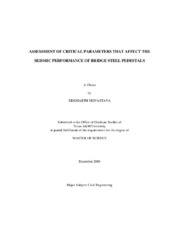| dc.description.abstract | The Georgia Department of Transportation has been installing steel pedestals on bridges, ranging in height up to 33½” (0.85m) to increase the vertical clearance of many multi-span simply-supported and multi-span continuous bridges in Georgia. But there is a concern about the performance of these steel pedestals as they are designed without seismic consideration and may perform poorly compared to high-type steel “rocker” bearings, which were found to be unstable supports in previous earthquakes. This research models a candidate bridge using experimental data that captures the force-displacement hysteretic behavior of the steel pedestals. The results show how these steel pedestals behave when subjected to a range of ground motions. Nonlinear time history analysis is conducted using SAP 2000 software on a three-dimensional model of the candidate bridge. In addition, parametric studies of various critical parameters that can affect the seismic performance of the bridge are investigated, such as 1) varying the mass of the structure, 2) varying the stiffness of the deck joint, 3) varying column heights, and 4) seismic retrofitting using cable restrainers.
The results show that these pedestals should not be used in regions of high seismicity, and in regions of low seismicity, it is likely that they need to be retrofitted. They can, although, be used safely in regions of low seismicity. In addition, it was shown that the mass of a superstructure and height of the columns significantly affect the behavior of these steel pedestals, and should be given a careful consideration before usage. It was also shown that the stiffness of the expansion joints does not significantly affect the displacement of the steel pedestals and the forces transmitted to them. However, if the expansion joints are too stiff compared to the adjacent bridge components, then the forces transferred during pounding of superstructure is increased significantly. | en |


